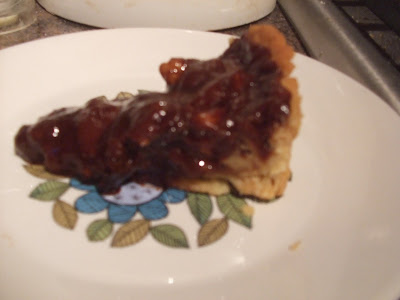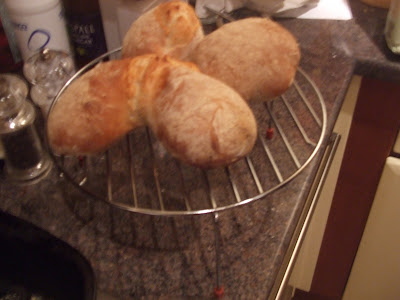i mean, take laura. she's pretty much the only person i socialize with in this two-horse town. i met her through my ex, and we insta-bonded over gender theory, literature, and an overabiding love of everything kanye west says. it's been what, about, seven months since i've known her, and even after things went right down the shitter with john, she and i have only gotten closer. it's a friendship founded on mutual repect and admiration, and, i know it sounds a bit overthought, but i'm neurotic enough to want my cooking to go perfectly in order to reflect that.
i decided, given that another of laura and my areas of common ground is love of thai food, the hotter the better, to keep things on an asian slant, but rather than going for something 'safe' like a red curry, i decided to make a laksa that caught my eye in (you've guessed it) good old nige's tender vol. I, to get the most out of the last of the pumpkins before i say goodbye to them until autumn. so without further ado:
a new pumpkin laksa for a cold night

pumpkin, unskinned, 350g
coriander and mint leaves to finish
for the spice paste:
red birds eye chillies, 3-4
garlic - 2 cloves
ginger, a thumb sized lump
lemongrass, 2 plump stalks
coriander roots, 5 or 6
coriander leaves, a handful
sesame oil, 2 tablespoons
for the soup:
chicken or vegetable stock, 600ml
coconut milk, 400ml
nam pla (thai fish sauce), 2 tablespoons (kirsty's note, obviously substituted for light soy)
tamari, 1-2 tablespoons, to taste
the juice of a lime
100g dried noodles, cooked as per packet and drained.
peel and seed the pumpkin and cut the flesh into large chunks. cook in a steamer or a metal colander balanced over a pan of boiling water until tender. remove from the heat.
for the spice paste, remove the stalks from the chillies, peel the garlic, peel and roughly chop the ginger and lemongrass. put them all into a food processor with the coriander roots and leaves and sesame oil and blitz until you have a rough paste.
get a large, deep pan hot and add the spice paste. fry for a minute, then stir in the stock and the coconut milk and bring to the boil. allow to simmer for seven to ten minutes, then stir in the nam pla, tamari, lime juice, pumpkin and the cooked and drained noodles. simmer briefly, add the coriander and mint noodles over the top, and serve in deep bowls.
okay, so, forgive the blurry picture, i was half cut by the time this got served, having been tasting wine and various spirits and mixers all day then hitting the chardonnay when i got home. this is, what i would refer to as a pretty good little midweek post-work recipe (did i not usually work until gone midnight), but then, i almost always have enthusiasm for my kitchen, so your mileage may vary. it only took about half an hour to cook in total, and that was mostly because the pumpkins and squash that make it to january are usually the monstrously big, slightly more fibrous specimens that have toughed out long periods of storage and therefore take longer to steam. it came up a treat, i mean, i loved it, but that's a given since it's precisely the kind of spicy bowl-food i go in for, but, despite having never had vietnamese food or squash before, it ticked all laura's boxes, too. she has, actually, after discussion over this, with no pushiness from me, cos i don't go in for that, decided to do a meat-free month in february. i like to think my vibrant, spicy-sweet little number may have helped.
for dessert, i stuck firmly to my comfort zone. the first desserts i learned to make, perversely, were cream and egg-white based. you know, the kind that usually daunt newcomers to the cooking scene? i've always been a bit like that, my earliest delve into literature proper was the russians, swiftly followed by kafka, so my accidental top down approach to things is a bit of a recurring theme, it would seem. i think, with the dessert thing, it stems from the fact i started out mostly baking as opposed to cooking proper, so i have no fear when it comes to whisking. i wanted something sweet and decadent that wouldn't be too heavy, so i flicked through my green and black's chocolate cookbook (an uncharacteristically thoughtful present from my little brother one christmas when i was an undergrad) and quite by accident, came up with another nigel slater gem:
white chocolate and cardamom mousse

8 plump green cardamom pods
100ml milk
3 bay leaves
250g good quality white chocolate, broken into pieces
300ml double cream
3 large egg whites
cocoa powder for dusting
crack open the cardamom pods and extract the seeds. crush them lightly and then put them in with the milk and the bay leaves in the saucepan. gently warm the milk until it is close to boiling point, then remove from the heat and set aside to infuse.
melt the chocolate in a heatproof bowl suspended over a saucepan of barely simmering water. as soon as it starts to melt, turn off the heat, leaving the bowl in place, and stirring occasionally.
whip the cream to form soft mounds, it should not be stiff. whisk the egg whites until stiff peaks form. once the chocolate has melted, remove from the heat and sieve the warm milk mixture into it. mix the chocolate and milk together until velvety.
stir in a spoonful of the egg whites to the chocolate mixture, then gently fold in the remaining egg whites using a large metal spoon. gently fold in the softly whipped cream. spoon into containers and refrigerate for 4 hours, dusting with cocoa just before serving.
so, as you can see from the picture (taken of a leftover one the next day, i was way too far gone at this point to be taking any pictures), these little puppies actually lost a lot of air in the fridge, but still somehow managed to remain texturally correct. i would absolutely recommend this recipe, it managed to be sweet without being cloying, something i find difficult with white chocolate (nigella's white chocolate mint mousse, for example, damn near gave me a migraine). if i'd been a little less time-pressed i might have whipped up some pistachio biscotti to go with these, but sadly my jam-packed bar superstar schedule did not permit it. it did the job pretty well on it's own, wowing my girl and even reducing me to almost silence in the eating (a feat more admirable than you may assume). in fact, laura enjoyed herself so much we're going to make this a monthly-at-least occurence. i'd call that a success.

































